




|
|
Frequently Asked Questions
Question. Of the many rowing cruiser designs in the Middle Path Boats
line, why did you choose the 16' Skua to be the first one offered in fiberglass?
Is it because Skua is the lightest, fastest, most stable and most seaworthy?
Answer. Skua is not, never was, and was never
intended to be, either our lightest, fastest, most seaworthy or most stable
design. It is, however, one of our most versatile: combining stability,
efficiency, seaworthiness, capacity and elegant styling in a boat that can be
lifted onto a car's roof rack by a typical couple when produced in a strong,
affordable lay-up. So, if your family includes anglers, campers, small children,
pets or anyone seeking safe, healthful, outdoor recreation you can't go wrong
with a Skua.
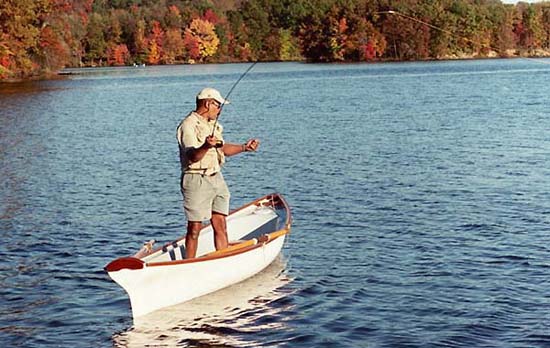

Question. I've noticed that most of your fixed seat rowing craft have two
pairs of oarlock sockets. Does that mean that they can be rowed double?
Answer. All of our boats can be rowed by two
persons, but only our 18 footers are specifically designed for double rowing. A
well-designed boat of up to 16 feet can be efficiently propelled near its
theoretical hull speed for sustained periods by a single rower. Adding another
rower to a boat of that length would only overpower the hull and be wasteful of
energy. The second rowing station on our 14 and 16 foot models is for achieving
proper trim (generally level) under various loads.
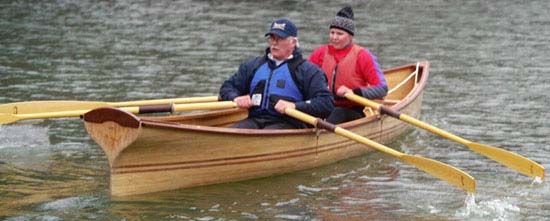
18' Skua XL
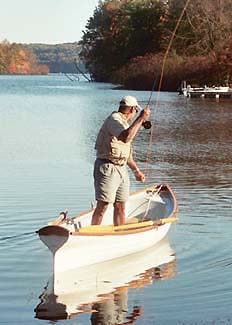 Question. I'm looking for a lightweight, efficient rowing cruiser.
Several people I've talked to have recommended an Adirondack Guideboat. I've
tried two, from different makers, and found them both to be fast, but too
tippy and low-sided for comfort on my home waters. Your Skua is similar in
length and beam to a typical Adirondack Guideboat, should I expect it to
behave similarly?
Question. I'm looking for a lightweight, efficient rowing cruiser.
Several people I've talked to have recommended an Adirondack Guideboat. I've
tried two, from different makers, and found them both to be fast, but too
tippy and low-sided for comfort on my home waters. Your Skua is similar in
length and beam to a typical Adirondack Guideboat, should I expect it to
behave similarly?
Answer. The speed of Adirondack Guideboats is
legendary, but they should be just as famous for their on-center tenderness.
Many people are understandably drawn to the Guideboat's sleek lines and
sweeping curves only to be surprised on their first row by the quick motion of
these craft in the roll plane (side to side).
The Adirondack Guideboat has considerable deadrise in its sections, slack
bilges and carries its volume relatively high. The guideboat's impressive
reserve stability only makes itself felt after it reaches a fairly steep angle
of heel. Skua, on the other hand, has a flatter bottom, a broader waterline
beam and lower, firmer bilges topped by rounded, flaring sides. This
combination yields a craft with good initial stability and steadily rising
resistance to heeling as its gunwale approaches the water.
The center depth of a typical Adirondack Guideboat is 12" while the least
depth of our 16 foot Skua is 14". As for speed and dryness, Skua's record on
the open water racing circuit is the best testament to this design's
efficiency and seaworthiness.
|

Center sections of 16' Skua and 1905 H.D. Grant 16' Adirondack Guideboat
Adirondack Museum, Blue Mountain, NY. |
|
Question. Your literature states that your Skua dominated the Fixed Seat
Open-Water Racing circuit in the mid-1990s. Why haven't we heard much about
Skuas winning races lately?
Answer. This answer requires a brief history
lesson. In the Victorian Era rowing was the most popular outdoor sport in
America. Back then everybody knew the differences between workboats, pleasure
craft and boats designed and built for competition. In those days, a boat of
Skua's weight and general dimensions would have been considered pretty normal
for a recreational craft. With the coming of reliable and affordable outboard
motors in the early years of the 20th century, the general population gravitated
toward modernity and ease, and they soon forgot almost everything they knew
about "old fashioned" things like rowing craft and oarsmanship. For about half a
century just about the only visible remnants of the Golden Age of rowing were
Ivy League racing teams and a few coastal workboats preserved in maritime
museums. Somehow, in the years following World War II, the notion got started
that heavy, obsolete, coastal workboats would make good recreational rowing
craft. That concept was reinforced in several widely distributed books, written
by well-respected authors that were published between the 1950s and 80s.
By the early 1990s, when Skua was designed, her dimensions seemed radical by
comparison to those stodgy and inconvenient craft. At that time racing in open
water was the only way to publicly demonstrate Skua's seaworthiness. By winning
so often, and so convincingly, Skua also proved her efficiency..
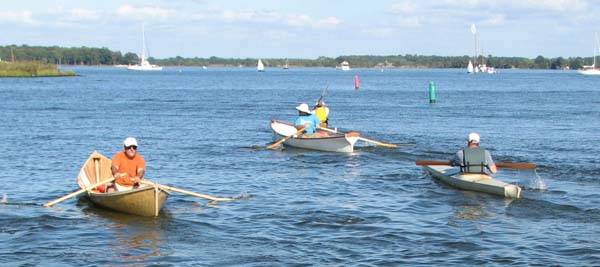
At the Mid-Atlantic Small Craft Festival XXV in October 2007 Brian Schexnayder showed
that Skua still has what it takes when he won the Men's Rowing Race, again.
|
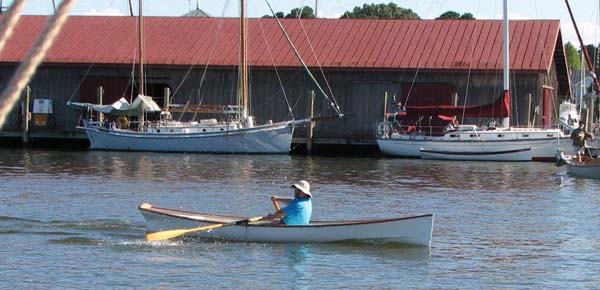 |
For a company like Middle Path Boats, which has only produced user-friendly
cruising designs, all that competitive glory has been somewhat of a mixed
blessing. Against an overwhelming, and as yet largely unchallenged, literary
backdrop of workboat lore, our sleek Skua looked to many people like a "racing
boat". To some of those persons "racing boat" = unsafe. Our records indicate
that Skua owners are 50 times more likely to be retirees than serious racers.
So, having demonstrated Skua's capabilities in the coastal environment, and not
wanting to frighten away much of our intended market, after the 1995 racing
season, we withdrew our active support of high profile racing efforts.
Soon after that we learned just how much happenings on the racing circuit
influence the broader recreational rowing community. In Skua's absence other
builders jumped on the bandwagon and entered the fray with their own lightweight
offerings and in no time the average weight of new fixed seat recreational craft
dropped dramatically. Unfortunately, this was also a time when many buyers
discovered that there is more to designing a safe and efficient seaboat than
simply making it light and skinny. Quite a few also learned that having a long
and storied history is no guarantee that a design will be suitable for general
use in open water. They found out the hard way what we knew so well, race
results alone don't tell you much about the overall handling qualities of
various boat types. Sadly, after all these years, race results are still the
only hard data available for readers to compare the relative performance of
different boats.
Skua owners know that there is nothing demanding or intimidating about owning or
rowing a well-designed, high-performance boat. In the future, we hope this
design will be noted more for its seminal role in the recent trend toward
practical, efficient recreational rowing craft than for its record on the race
course.
From time to time, Skuas are raced, and when they are, they are always among the
favorites to win.
Question. What kind of person buys a Middle Path boat?
Answer. We've noticed that a great many of our
clients are teachers or engineers. It makes us extremely proud when such
thoughtful and analytical types choose our boats. They tell us how much they
appreciate that we can cite facts based on personal experience and observation
rather than merely repeating stories from history books. Some of our customers
are won over at boat shows where we are able to demonstrate that our lightweight
rowing cruisers can do everything that heavier workboat replicas can, only
better, and with less fuss. A sizable percentage of our clients purchase our
boats as replacements for more famous designs that didn't quite meet their
expectations. All of our customers are smart persons with a practical
understanding of the laws of physics and how they affect their chosen form of
recreation. They know that a boat which typically carries a load of one or two
people is unlikely to see much use if it requires a team of four or more persons
to launch and retrieve. And, they know how hard it is to enjoy a boat that
doesn't provide a sense of security on their home waters.
Question. Where can I see, or try, one of your boats?
Answer. Of course, you are welcome to come by our
shop and learn, first hand, from the people who know them best. We only ask that
you call well in advance of your visit so that we can set aside the necessary
time to properly familiarize you with our products. You can also see, and try,
our boats at various small craft shows and gatherings around the country. This
year you can see us at:
- The Mid-Atlantic Small Craft Festival at the Chesapeake Bay Maritime Museum
(www.cbmm.org) on first weekend in October.
If you know of other established events where we can show our boats to good
effect, please let us know about them.
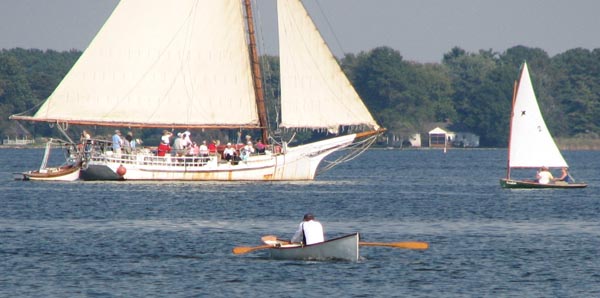
Paolo Frigerio running away from the field in the Men's Rowing Race
at the Mid-Atlantic Small Craft Festival XXVII in 2009.
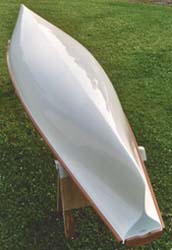 Question. I've noticed that your boats have no keels or skegs. How well
do they track?
Question. I've noticed that your boats have no keels or skegs. How well
do they track?
Answer. Keels and skegs aren't necessary on rowing
craft for tracking. Indeed, high performance racing and cruising canoes
dispensed with them decades ago.
Underwater appendages are liabilities on the hulls of human-powered craft. They
are subject to being grabbed or damaged by unseen obstacles or caught up in
errant currents. Any desired degree of directional stability can be achieved by
manipulating the shape of the hull. Factors like waterline length, hull sections
and the amount of rocker can all affect a boat's tracking and maneuverability.
Keels and skegs are vestiges of 19th century design, shaped by the technologies
of the day, when boats were made of many pieces of wood held together by nails
and screws.
Question. Would I have to remove the fixed center seat to install a
sliding seat rig in one of your boats?
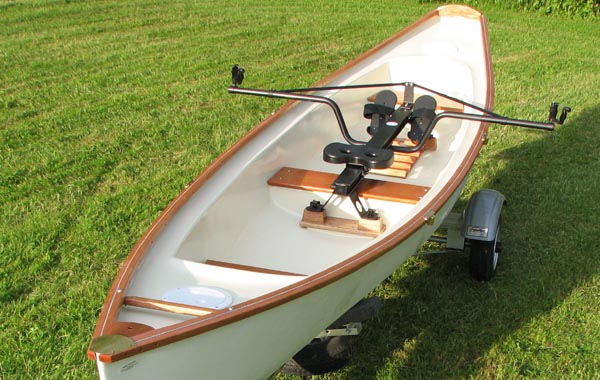
Skua with sliding seat
Answer. No. The rowing sled fits in over the center
thwart. Also, the entire sliding seat apparatus can be installed and removed in
seconds, without tools.
Question. If I installed a sliding seat rig in a 16' Skua would I be able
to row it faster than I could from the fixed seat?
Answer. No. The extra power of a sliding seat and
9'-10' sculls will not make a 16 foot boat go any faster. Speed in a
displacement (non-planing) craft is determined by waterline length: the longer
the waterline, the greater the speed potential. Skua is optimized for efficient,
long distance, fixed seat rowing. Experiments have shown that there is a point
of diminishing returns regarding length when designing for speed in open, fixed
seat craft. With a single rower that point is around 16 feet. Beyond that length
any potential performance gains are increasingly offset by increases in weight,
wetted surface (friction) and windage.

Brian Schexnayder gives the rest of the field a good look at Skua's shapely transom
on his way to winning the Men's Fixed Seat Rowing Race at the MASCF XXI.
A strong oarsman can keep Skua moving near hull speed for
extended periods. The sliding seat method was developed for use in extremely
long, extremely light, extremely narrow, low-profile, flatwater rowing shells.
The farther a boat and the conditions depart from those parameters the less it
will benefit from the power potential of the slide. Firing those huge quads to
work the slide will only produce bigger waves and tire you faster. Sliding seat
rowing is efficient exercise but makes for inefficient transportation. The
results of mixed class, open water races show that 15'-17' sliding seat shells
are no faster than the better fixed seat rowing craft.
Question. You say your boats are car-toppable. I have a small sedan with
a 4 cylinder engine. Can I safely carry a Skua on the roof of my car?
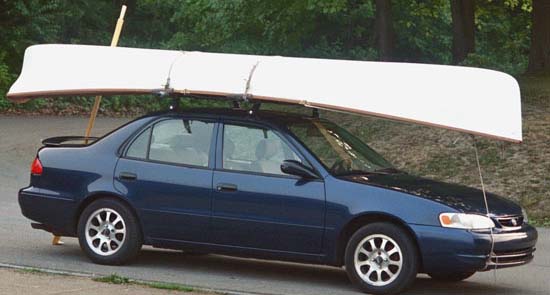
Skua + roof rack + compact car = the world
Answer. Probably. The best rack manufacturers
(Yakima, Thule etc...) offer sturdy rack systems to fit most cars. Any canoe or
bicycle shop should be able to help fit your car with the proper set-up. You
should also consult your car's owner's manual about its rooftop carrying
capacity. A fit couple can usually hoist a 100 lbs craft onto the roof of a car.
If you don't have a boating partner you might want to consider ordering a
lightweight trailer to transport your Skua. Middle Path Boats is an authorized
dealer for the superb line of Trailex aluminum trailers. Trailex SUT trailers
are long lasting and singularly gentle to small, lightweight watercraft. All
Trailex SUT trailers are D.O.T. legal and many can double as hand pulled
carts. They can be trailed behind the smallest vehicles. The all up weight of a
Skua, with oars and life jackets, on a SUT-220-S trailer is under 250 lbs. With
some of these trailers you'll never even have to lift your boat. Just float it
on and off your trailer. One client commented that trailers like these should
come as standard equipment with all lightweight, human-powered boats. The more
experience we have with these trailers the more we see his point. Even if you
think you don't like trailers, a Trailex SUT trailer may be the perfect
accessory for your boat. By ordering your trailer from Middle Path Boats you can
save money and take advantage of our proximity to the Trailex factory. More
importantly, you can benefit from our unique knowledge of both the boats and the
trailers. You can check out the complete Trailex line at www.trailex.com.


Skua on Trailex SUT-220 S Trailer
Question. Most high performance, fixed seat rowing craft are matched with
long oars and that seems to be the case with Skua. Some designs demand an
uncomfortable cross-handed rowing technique. With Skua will I have to row with
crossed oar handles?
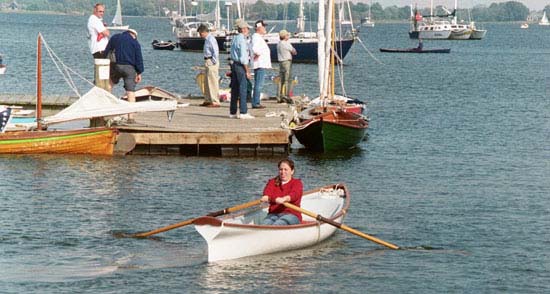
Answer. No. Skua's maximum hull beam is the
minimum necessary to achieve a sufficient spread between oarlocks to accommodate
a pair of long, efficient oars without resorting to inconvenient and complicated
devices like outriggers. Also, we have our custom sewn oar leathers placed so
that the oar grips pass cleanly, without overlap, on both the power and recovery
phases of the stroke. Outriggers can be a genuine liability on a cruising craft.
They often place concentrated stresses on a hull and they can make it difficult
for a rowing craft to closely and safely pull alongside docks, seawalls and
other boats.
Question. Can a Skua be fitted with a sailing rig?
Answer. Yes, but it shouldn't be done. Some people
can't resist the temptation to convert a pretty rowing boat into a sailboat. The
design requirements for rowing and sailing differ enough that any hull which has
been optimized for rowing will not be a sterling sailer, and any boat that sails
like "a real sailboat" will not row like the best rowing craft. Putting a set of
oarlocks on a nice sailing dinghy probably won't negatively affect its sailing
qualities, but almost any alteration or addition you make to a high performance
rowing craft in order to make it sail will adversely affect its comfort,
efficiency and perhaps its safety. Under oars Skua can go faster on all points
than most dinghies ever sail. Cutting up or cluttering up a hull like Skua's in
an attempt to make it sail will only compromise this design's extraordinary
rowing performance. There are very few rowing craft that can prepare you for the
remarkable efficiency and civility of a hull like Skua. We strongly urge Skua
owners not to waste time, money and effort turning one of the worlds most
sophisticated rowing cruisers into something less.
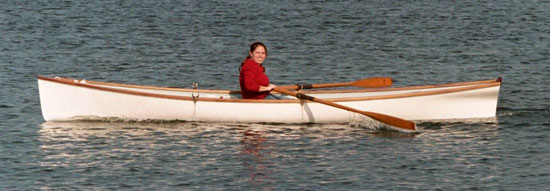
Lacey England pulling Skua to victory in the Women's Fixed Seat Rowing Race
at Mid-Atlantic Small Craft Festival XXI in St. Michaels, MD.
|






Question. I'm looking for a lightweight, efficient rowing cruiser. Several people I've talked to have recommended an Adirondack Guideboat. I've tried two, from different makers, and found them both to be fast, but too tippy and low-sided for comfort on my home waters. Your Skua is similar in length and beam to a typical Adirondack Guideboat, should I expect it to behave similarly?
Question. I've noticed that your boats have no keels or skegs. How well do they track?












